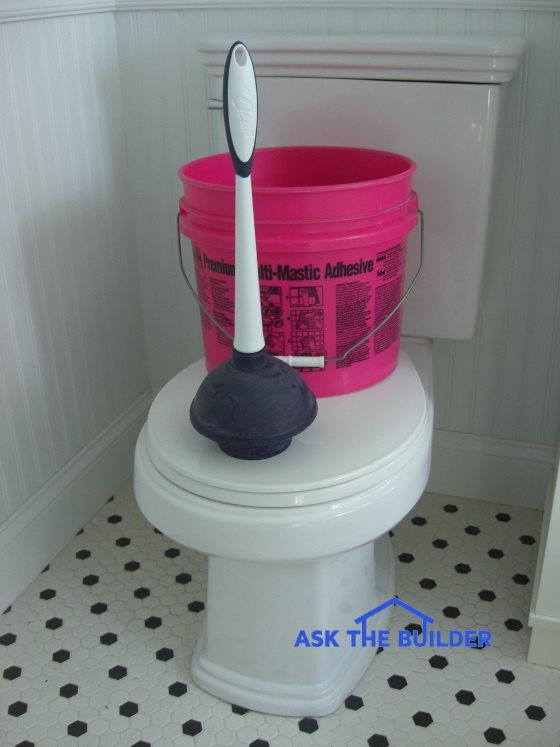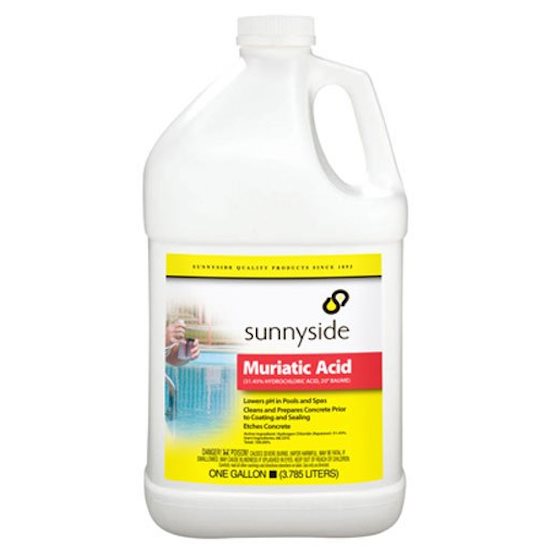Clogged Toilet

This plunger and a 3.5-gallon bucket are usually all you need to fix a clogged toilet. Copyright 2017 Tim Carter
"I've been a master plumber since age 29 and know how to clear most clogged toilets using nothing more than a few gallons of water."
Clogged Toilet Tips
- Toilet paper and poor toilet design cause most clogs
- Pour 3 gallons of water fast into a toilet bowl to remove a clog
- Watch the toilet flush video below
- Muriatic acid can fix slow-flushing toilets
- CLICK HERE to Get Tim's FREE & FUNNY Newsletter!
DEAR TIM: Every now and then I have to deal with a clogged toilet. But lately the blocked toilet seems to be happening with greater frequency.
I don't know if the toilet or a clogged drain line is the problem. What can I do to troubleshoot the cause of the problem?
Is it possible for me to damage the bowl while clearing a clogged toilet? What do you do when faced with this unpleasant task? Harmony T., Sandusky, OH
DEAR HARMONY: You'd be surprised how many folks are stymied by this common problem.
What's the Best Clogged Toilet Fix?
The best clogged toilet fix might be to just using more water to force the clog past the toilet colon.
Most toilet clogs happen within the curved passageway in the china. Water is heavy and you'd be surprised by how it can fix a clogged toilet.
Clearing a clogged toilet happens all over the world each day. While traveling, you could even come across a blocked toilet in London! I've dealt with my fair share of toilets that don't want to drain, some even in hotel rooms I've stayed in.
I've been a master plumber since age 29 and know how to clear most clogged toilets using nothing more than a few gallons of water.
Also, poor toilet internal design and using too much toilet paper are almost always the cause of most clogged toilets.
This trick was covered in the DIY Plumbing Advice column also.
Free & Fast Bids
CLICK HERE to get FREE & FAST BIDS from local plumbers if you can't dislodge the clog on your own.
Related Links:
How To Clean Tough Toilet Stains
Why Does a Toilet Clog?
A toilet clogs because toilet paper, solid waste and other debris gets stuck in a narrow passageway behind and under the toilet bowl. This passageway is called the colon.
You probably have never seen what the underside of a toilet looks like or seen the piping system that connects to a common residential toilet. If you did, you'd probably shake your head wondering how they don't get clogged more often.
Toilet bowls have a colon. A colon is a convoluted pathway inside a toilet bowl. It's much the same as a curvy road rally course with one or more hairpin turns. It's called a colon because it resembles your own large intestine! This pathway inside the toilet bowl helps create the water seal keeping sewer gas and vermin from entering your bathroom.
Do Toilet Drain Lines Clog Frequently?
A toilet drain line is the pipe in the floor under the toilet. These lines rarely clog. Almost all clogs are in the actual toilet.
The diameter of this colon is usually over 2 inches, and it connects to a 3-inch drain pipe in the floor. In some houses, the drain line may even be a 4-inch pipe.
If waste and paper can make it through the colon in the toilet, you can see that the larger drain pipe in the floor can easily accommodate the waste from the toilet. Hence, this is why a clogged drain line is almost never the problem.
How Can I Test to See If My Toilet Drain Pipe is Clogged?
You can do a quick test to see if the drain pipe in the floor is clogged. You just have to pour water into the toilet bowl fast.
It's important to realize you should make sure the toilet is flushing normally before you test to see if your drain line or colon is clogged or partially clogged. If you see the water swirl around the bowl and disappear with that classic slurping noise, you're ready to begin the test.
Fill a 5-gallon bucket with water and pour it into the toilet bowl as fast as you possibly can. I mean quickly!
If the toilet bowl does not overflow, this means that the toilet colon and the drain line are wide open. A plastic army man wedged in the colon allows the water to pass. However, the toy can block toilet paper and solid waste.
What Toilets Clog Most Often?
The toilets that clog most often are those with a sharp 90-degree bend where the colon ends at the underside of the toilet bowl. Toilets that have slow water flow from the tank to the bowl clog because the water is not getting into the bowl fast enough.
If the water from the bucket drains rapidly, you could still have a design problem with the toilet. I've seen discount toilets that have a very tight turn at the end of the colon where it connects to the drain pipes at the floor.
Solid waste and toilet paper can have a tough time passing through this very tight turn. High-quality name brand toilets don't have this design flaw.
Bucket Of Water Flush Video
Watch this very short video showing how small volumes of water do nothing to flush a toilet, but lots of water work to flush!
Do Water-Saving Toilets Clog More Often?
First-generation water-saving toilets do clog more often than newer toilets that have a better design.
The Federal government passed laws years ago. The laws limit the amount of fresh water that can be used to flush a toilet.
Toilet manufacturers rushed to create toilets that conformed to this law, but some toilets would not flush well.
If you want a great flush, you need to have the water from the tank enter into the bowl as rapidly as possible.
CLICK HERE to get FREE & FAST BIDS from local plumbers if you can't dislodge the clog on your own.
Why Do Commercial Toilets Flush So Fast?
Commercial toilets flush fast because they use high-pressure water from water supply lines to do the flushing. There is not storage tank of water like you find on the toilet in your home.
This is why commercial toilets you use all the time don't have a tank. They use the high pressure from the water supply lines to create the flush.
The chrome valve assembly that you see at the airport, shopping mall, or rest stop toilets creates loud and furious "whooooshing" flush. The Sloan company makes most of these chrome valves. They inject lots of water FAST into the toilet bowl whisking away the waste.
How Can I Prevent Toilet Bowl Damage?
You can prevent toilet bowl damage by not using anything metal to unclog the toilet.
You can damage a toilet if you use the wrong tools while fixing a clogged toilet. Therefore I'd only use a plunger and a bucket of water. That's all I've ever used in all the years of working on toilets. The clogged drain snakes made from flexible metal can scratch the polished china surface of your toilet if you get too aggressive.
As crazy as this sounds, water alone can often fix a clogged toilet without a plunger. You may have noticed in the past that when a toilet clogs, the toilet bowl fills with water from the tank but doesn't overflow. But when you come back minutes later to look at it, the water level in the bowl has mysteriously fallen.
Why Does Water Leak Slowly Past The Clog?
Water leaks slowly past a clog because of simple hydrostatic pressure. The nasty water that's almost overflowing in the bowl is higher than the top of the water seal trap in the toilet bowl. When the water drops to that level, no more water seeps past the water seal in most instances.
This happens because water from the bowl is seeping by the clog. Wait for the water level in the toilet bowl to drop on its own. Pour a bucket of clear water into the toilet as fast as you can. In addition, be sure the water doesn't splash out or overflow the rim of the bowl. The rush of the water dislodges most clogs.
I only use a plunger when several buckets full of clear water don't do the trick. Be sure the toilet bowl has more water in it than the normal level of water when using the plunger. The weight of the water, in addition to the action of the plunger, is what helps to clear the clog.
Should I Scoop Out Some Of The Nasty Water?
You need to scoop out lots of the nasty water in the toilet bowl to unclog it. Dump this water in an old bucket. Once the toilet is unclogged you can dump it back into the bowl to dispose of it.
You don't want to use a plunger when the water in the toilet bowl is almost overflowing the rim of the bowl, because you'll have a real mess on your hands. Remember that water is heavy and its weight alone can persuade a mass of toilet paper and solid waste to pass through the toilet colon.
Do Hard Water Deposits Slow Water?
Mineral deposits that collect around the siphon jet hole in the bottom of the toilet bowl can also cause the problem. The water from the toilet tank needs to enter the toilet bowl rapidly to force waste through the toilet into the drain pipe. A partially clogged siphon jet hole can mimic a clogged toilet.
Most of all a flapper valve can fool you. Flapper valves can close too rapidly not allowing enough water to enter the bowl.
The bucket-of-water test can clear clogs caused by this. Muriatic acid will dissolve hard water deposits that are clogging the siphon jet hole.

Muriatic acid is powerful and needs to be treated with lots of respect. CLICK THE IMAGE TO ORDER SOME NOW.
Should Clean Clear Water Be in the Bowl Before Using Muriatic Acid?
Clear water should be in the bowl before you try muriatic acid. The toilet must be free of clogs. Pour a bucket of water rapidly into the toilet bowl to lower the water level in the bowl. Then add 12 ounces of muriatic acid to the water in the bowl. Allow it to sit in the toilet for several hours.
First of all be sure to wear goggles and old clothes as you do this. Pour the acid into the toilet slowly to minimize splashing. Open the bathroom window to ventilate the harmful fumes. Put the toilet lid down so that animals can't get into the harmful brew.
Are Wood Sticks the Best Thing to Use To Scrape Deposits?
After waiting several hours, and wearing rubber gloves, carefully use a small wooden stick to gently scrape the opening of the siphon jet hole. Do not use any metal to do this.
Before you flush the toilet, it's a good idea to neutralize the acid. You can use a cup of baking soda to achieve this goal. Add it slowly to the liquid solution in the bottom of the bowl and stir it with a paint-stirring stick.
Flush to Check For Progress
Now it's time to flush the toilet to see if the acid did its job. If deposits clogged the siphon jet hole, you should see a significant difference in the flushing action. The acid will not hurt the toilet bowl or the plumbing drain pipes.
In conclusion, you now know that you can use water and muriatic acid to solve most toilet clogs.
Patrick had an issue with his toilet clogging all the time. Read his story in the May 29, 2009 Newsletter.
CLICK HERE to get FREE & FAST BIDS from local plumbers if you can't dislodge the clog on your own.
Column 855


33 Responses to Clogged Toilet